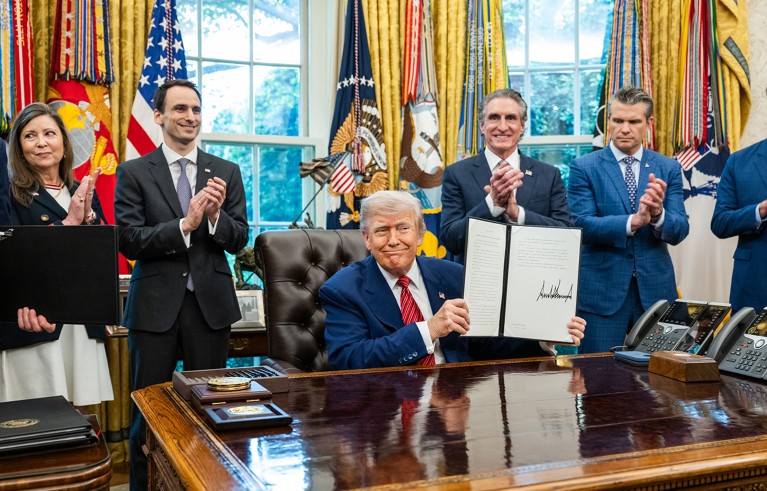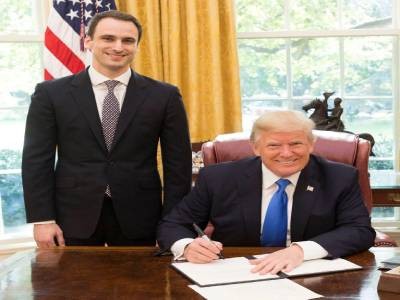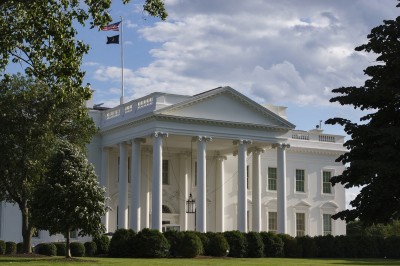The election of US President Donald Trump last year triggered widespread concern in the US scientific community, but some researchers saw a glimmer of hope in the form of Michael Kratsios — the president’s chief science adviser. Scientists who had worked with Kratsios during Trump’s first presidency, from 2017 to 2021, had mostly good things to say when Trump nominated him in December: although Kratsios is not a scientist, he had previously shown support for science and a willingness to listen to and work with the scientific community.
Researchers also took it as a positive sign that Kratsios’ nomination to lead the White House Office of Science and Technology Policy (OSTP) came early, and that he was given the official title ‘assistant to the president’, which theoretically grants him easier access to Trump. Kratsios’ predecessor from the first Trump administration, meteorologist Kelvin Droegemeier, arrived two years into the president’s term and without such a title.
In the announcement in late December, Trump credited Kratsios’ previous service as the US chief technology officer and his brief role overseeing defence research. Along with the announcement, Trump promised to “unleash scientific breakthroughs, ensure America’s technological dominance, and usher in a Golden Age of American Innovation!”
Trump’s science advisers: how they could influence his second presidency
Now, four months after his Senate confirmation, Kratsios is beginning to make his mark as he pushes the president’s science agenda. Although some scientists and scholars are withholding judgement for now, many feel dismayed. In their view, Kratsios has done nothing publicly to defend science, even as the Trump administration slashes science budgets, terminates research grants and projects, fires government scientists and attacks universities. His public comments have typically reinforced the administration’s arguments that science and academia, like government, have become liberally biased and bureaucratic institutions that need to be downsized and then jolted back to life.
In particular, Kratsios’ first major initiative — a directive calling on federal agencies to promote ‘gold standard science’ — has attracted widespread criticism for undermining and politicizing science. Most crucially, the guidance expands political power over sensitive science topics and questions of alleged research misconduct. When Kratsios defended the effort in an editorial in the journal Science on 24 June (M. Kratsios Science 389, 7; 2025), one of his predecessors, John Holdren, went so far as to publish a letter in Science accusing Kratsios of deploying Orwellian doublespeak to defend a proposal that will further enable the Trump administration’s attacks on science. “And now the fox in the henhouse overseeing it all is Michael Kratsios?” wrote Holdren, a physicist at Harvard University in Cambridge, Massachusetts, who served as science adviser to former US president Barack Obama. “What a charade!”
Holdren is not alone. “We were really hopeful that Kratsios would defend science, but it doesn’t look like he is going to do that,” says Kenneth Evans, a science-policy researcher at Rice University in Houston, Texas. The question now, Evans adds, is whether Kratsios and the Trump administration will present a positive agenda for science. “Tearing everything down doesn’t seem like a way forward.”
Kratsios declined multiple interview requests from Nature, and the OSTP declined to comment on the allegations in this article.
Political science
Kratsios earned a bachelor’s degree in politics at Princeton University in New Jersey in 2008, but quickly moved to finance. In 2010, he went to work for the controversial Silicon Valley billionaire Peter Thiel, a co-founder of PayPal and an early investor in Facebook, who runs a venture-capital firm with a focus on technology companies. Thiel is a critic of the modern science and innovation system and a long-time supporter of Trump.
Kratsios’ early supporters credit him with pushing new strategic policies on artificial intelligence (AI) and quantum computing forwards during his first stint in the White House. They also say he kept the OSTP office running until Droegemeier was confirmed in January 2019.

In May, Michael Kratsios (second from left) joined US President Donald Trump and other members of the administration when Trump signed several executive orders, including one titled Restoring Gold Standard Science.Credit: Molly Riley/Official White House Photo
“For two years, we had no director, and he was really holding down the fort,” says Tobin Smith, senior vice-president for government relations and public policy at the Association of American Universities (AAU) in Washington DC. Smith says the AAU’s interactions with Kratsios were positive during the first administration, but says it’s too early to say what the OSTP might get done under his watch this time around. “The verdict is still out.”
Unlike Droegemeier during Trump’s first administration, Kratsios has not shied away from speaking out — and doing so in highly political terms. In his first policy speech at a conference in Austin, Texas, on 14 April, less than three weeks after his confirmation, Kratsios accused the administration of former president Joe Biden of leading with “a spirit of fear rather than promise” and “promoting social division and redistribution in the name of equity”. He then laid out a bleak assessment of US science, arguing that the US innovation system must be renewed to achieve “the Golden Age of American innovation”.
“As we look forward to America’s 250th birthday celebration next year,” he said, “our progress today pales in comparison to the huge leaps of the 20th century.”
Different kind of science adviser
Several scientists who have worked directly with Kratsios expressed little doubt that he wants to promote science and technology, whether by reducing bureaucratic paperwork or introducing new funding models to encourage innovative research. He leans into areas such as AI, nuclear power and drones, and he wants to produce tangible change rather than written reports, says one scientist who recently departed the OSTP and requested anonymity to speak freely about their time with Kratsios.
“I do think he cares deeply about the American science and technology enterprise,” says the scientist, “but he’s more of a technologist than a scientist”.
And that is precisely the problem, says Michael Lubell, a physicist at the City College of New York in New York City, who has studied the history of US science policy. Science advisers dating back to the Second World War varied by discipline and philosophy and served administrations of different political stances, Lubell says, but they were all scientists or engineers who could represent and speak to the research community. He says Kratsios’ expertise rests with technology.
Trump’s call for ‘gold standard science’ has prompted an outcry: here’s why
“He does not come from the science community, he does not know the science community and he does not understand the intellectual content of the science community,” Lubell says. “He is a mouthpiece for the president.”
Several scientists who have worked with Kratsios say he has a knack for picking up scientific terms and ideas, knowing his audience and reading the political terrain. It’s unclear how he will balance competing demands in his current role. As science adviser and head of the OSTP, Kratsios needs to be responsive to the president’s priorities while representing the scientific community’s needs, says Gretchen Goldman, who leads the Union of Concerned Scientists, an advocacy group based in Cambridge, Massachusetts, and who worked on scientific-integrity policies at the OSTP under Biden. “Those two things are just fundamentally in opposition under this administration, so I don’t see how Kratsios could win.”
Kratsios caught many scientists and policy specialists off guard with his first signature initiative: the gold-standard-science policy, which Trump unveiled on 23 May in an executive order that also repealed scientific-integrity policies put in place across the federal government under Biden. Kratsios followed up with guidance laying out nine core tenets, starting with reproducibility and transparency, designed to ensure that science conducted or funded by the government is “beyond reproach”.
Although the basic framing sounds reasonable at first, Goldman and others have raised a host of criticisms. One is that a guidance document on the gold-standard-science policy issued by the OSTP contains transparency language that seems to echo a controversial ‘secret science’ rule put in place at the US Environmental Protection Agency (EPA) during the first Trump administration (see go.nature.com/4fnb9pk). The EPA rule, which was blocked by a federal court and killed by the Biden administration, sought to require that the underlying data for science used in public policy be made publicly available, but critics argued that the policy could eliminate the ability of epidemiologists and other researchers at the agency to rely on certain types of public-health data that cannot be released owing to rules designed to protect individuals’ privacy.
Will US science survive Trump 2.0?





